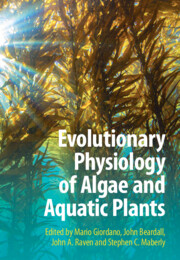Book contents
- Evolutionary Physiology of Algae and Aquatic Plants
- Evolutionary Physiology of Algae and Aquatic Plants
- Copyright page
- Contents
- Contributors
- Preface
- Acknowledgments
- 1 Environmental Changes Impacting on, and Caused by, the Evolution of Photosynthetic Organisms
- Part I Origins and Consequences of Early Photosynthetic Organisms
- Part II Physiology of Photosynthetic Autotrophs in Present-Day Environments
- 7 Light as a Major Driver of Algal Physiology and Evolution
- 8 Temperature: Still an Enigmatic Driver in the Evolution and Physiology of Algae
- 9 Nutrient Acquisition by Algae and Aquatic Embryophytes
- 10 Salinity
- 11 Desiccation
- 12 Trait Trade-Offs in Mixoplankton: An Analysis
- 13 Effects of Pollutants on Microalgae
- 14 Algae in Extreme and Unusual Environments
- Part III The Future
- Index
- References
12 - Trait Trade-Offs in Mixoplankton: An Analysis
from Part II - Physiology of Photosynthetic Autotrophs in Present-Day Environments
Published online by Cambridge University Press: 24 October 2024
- Evolutionary Physiology of Algae and Aquatic Plants
- Evolutionary Physiology of Algae and Aquatic Plants
- Copyright page
- Contents
- Contributors
- Preface
- Acknowledgments
- 1 Environmental Changes Impacting on, and Caused by, the Evolution of Photosynthetic Organisms
- Part I Origins and Consequences of Early Photosynthetic Organisms
- Part II Physiology of Photosynthetic Autotrophs in Present-Day Environments
- 7 Light as a Major Driver of Algal Physiology and Evolution
- 8 Temperature: Still an Enigmatic Driver in the Evolution and Physiology of Algae
- 9 Nutrient Acquisition by Algae and Aquatic Embryophytes
- 10 Salinity
- 11 Desiccation
- 12 Trait Trade-Offs in Mixoplankton: An Analysis
- 13 Effects of Pollutants on Microalgae
- 14 Algae in Extreme and Unusual Environments
- Part III The Future
- Index
- References
Summary
Mixoplankton are planktonic protists engaging in photo-autotrophy plus osmo-heterotrophy plus phago-heterotrophy, contrasting with non-phagotrophic phytoplankton (e.g., diatoms) and non-phototrophic zooplankton (e.g., tintinnids). All mixoplankton are mixotrophs, but not all mixotrophs are mixoplanktonic. Mixoplankton are often considered as inferior in their capabilities compared to diatoms that surrendered phagotrophy, and those zooplankton that lost phototrophy. However, such views undersell the synergistic activities of mixoplankton. Thus, the phototrophic capacity of mixoplankton provides a predatory phagotroph with a ready source of carbon and energy supplementing phagotrophy and retention of the 30% of resources that would otherwise have to be released in specific dynamic action. Phagotrophy brings in nutrients to support phototrophy. Beyond these generalisations, we know little about the whole integrated physiology and ecology of mixoplankton. To fully appreciate the comparative fitness of two species, we need to consider all aspects of their life cycles. The emphasis for plankton is usually placed on resource acquisition and the maximum specific growth rate without considering the metabolic and mortality costs of being unable to support the growth rate, and predatory pressures. This suggests that trait trade-offs are less useful for conceptual and simulation modelling than approaches more securely founded in physiology and evolution.
Keywords
- Type
- Chapter
- Information
- Evolutionary Physiology of Algae and Aquatic Plants , pp. 227 - 251Publisher: Cambridge University PressPrint publication year: 2024

